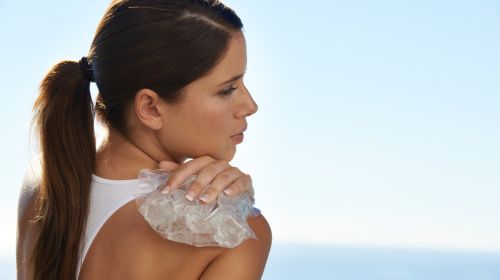Luxation is the medical term for dislocating or contorting joints. The bones that form a joint lose contact with one another – usually due to heavy stress or an accident. When the doctor can straighten the joint and when surgery is necessary.
- In addition to the shoulder and elbow, the patella (kneecap) is particularly often affected by dislocation (dislocation).
- © iStock.com/dragana991
The more flexible a joint is, the more often it is affected by dislocation: in half of the cases it is a shoulder dislocation, but the elbow, hip and patella (kneecap) can also be dislocated relatively easily. In ball sports, the fingers are often affected, and luxations of the jaw or on the spine are less common. If the joint is only incompletely dislocated, it is called subluxation.
Overview of article content:
Types and causes of dislocations
Experts distinguish four types of dislocations:
The traumatic dislocation arises from the effects of violence, for example in the event of an accident or a fall. The sudden and strong application of force to the joint often leads to further injuries to cartilage, bones, muscles, vessels and / or nerves.
The habitual dislocation results from a congenital or acquired instability of the joint. If the joints are excessively flexible, a minimal load is often sufficient to dislodge them.
Some people come with one congenital dislocation on the world. Here there is a malposition (dysplasia) of the joint that keeps it dislocated.
A pathological dislocation arises from chronic damage to the joint, inflammation of the joint with capsule stretching or joint destruction. Muscle paralysis can also be the cause.
In young people dislocations occur especially during sport, in older age there are often weak muscles or connective tissue. Inadequate stabilization by the so-called rotator cuff is often the trigger for luxation of the shoulder.
Symptoms of dislocation
Sudden massive pain is the most obvious symptom of dislocation – especially when trying to strain or move the injured joint. Most of the time, the original function is limited or no longer executable. In some cases the bones are visibly displaced, then the joint looks twisted or bent.
Because the tissue around the joint is sometimes injured, swelling and bruising occur in these cases. If the nerves are affected, the affected part of the body may feel numb.
First aid for dislocations
Dislocation is essential for examination and treatment by a doctor. The joint should be retightened as soon as possible to avoid soft tissue damage. The following first aid measures are advised until a doctor arrives or reaches you:
The affected joint should be immobilized as painlessly as possible, wraps or elastic bandages can help. It should always be wrapped from close to the body.
Elevating and cooling the joint relieve pain and reduce swelling. The lower the swelling, the easier it is to adjust later. Cool packs or ice cubes should never be placed directly on the skin.
Diagnosis: This is how the doctor recognizes a dislocation
If there is a suspicion of dislocation, a visit to the emergency room of a hospital is recommended, but at least to an orthopedic surgeon or trauma surgeon. This will question the person concerned about the course of the accident and carry out a detailed physical examination. After a visual comparison of the healthy and the injured half of the body, the affected joint is scanned and its mobility is checked. Blood circulation and sensitivity are also checked to prevent damage to blood vessels and nerves. If these tests are too painful, a pain reliever is given or injected.
In order to confirm the diagnosis and to be able to classify the luxation more precisely, an X-ray is taken in the next step. This is always done from at least two different angles in order to be able to assess the position of the bones relative to one another. If further injuries are suspected, an MRI is also performed to check the ligaments, tendons and muscles. In rare cases, joint mirroring (arthroscopy) is also performed.
Treatment of dislocation
Dislocation is treated either conservatively or surgically. If it is a first dislocation without an accompanying injury, the affected joint is repositioned (reduced) by the doctor. This so-called closed reduction is done by pulling and / or turning the joint and can be very painful – which is why it is often done under painkillers or under general anesthesia. A control X-ray is then taken to ensure that the bones are in the correct position.
If the conservative treatment is unsuccessful or the dislocation is accompanied by injuries to the bones, muscles, nerves and / or ligaments, surgery is usually necessary (open reduction). This procedure is performed under anesthesia and is often associated with hospitalization. Meanwhile, the doctor not only straightens the joint, but also treats other damaged structures.
The affected joint is immobilized both after the closed and after the open reduction. Plaster casts, slings or splints are mostly used for this. If possible, immobilization should not extend over more than three weeks, otherwise permanent joint stiffness is threatened. Physiotherapy should be started as early as possible to maintain or regain flexibility and strength.
Complications and prognosis in dislocation
Many dislocations heal without complications and without consequences after a corresponding therapy within a few weeks or months. In some cases, however, there is permanent instability of the joint and / or a new dislocation (reluxation). Chronic pain, cartilage or nerve damage, arthrosis or restricted mobility are also possible consequences of dislocation. Basically, the prognosis depends on the accompanying injuries, the therapy, the further treatment, the age and the cooperation of the person concerned.
This is how dislocation can be prevented
Muscles, ligaments and tendons stabilize the joints, and a stable joint does not dislodge so easily. Regular strengthening and coordination exercises therefore reduce the risk of dislocations. Defensive behavior and appropriate protective equipment prevent the risk of injury during sport. Those who are prone to dislocations should better avoid certain high-risk sports or use stabilizing bandages.


